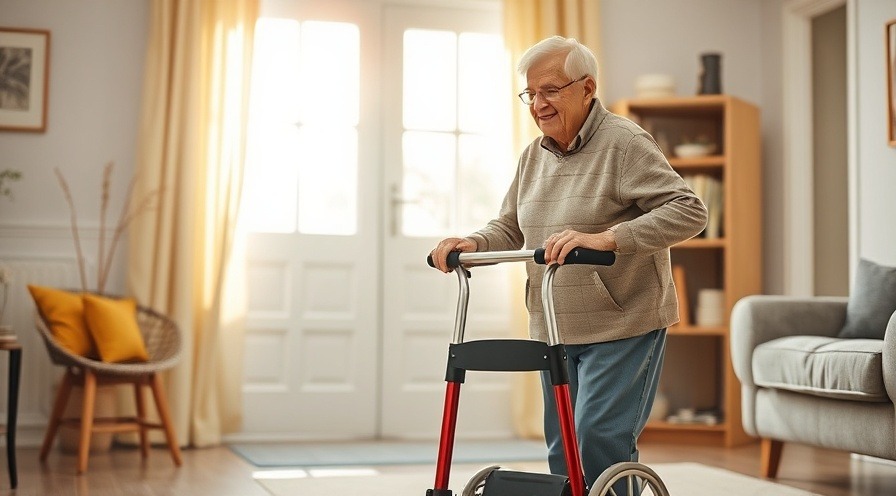
Imagine a world where we could predict the risk of Alzheimer’s disease before it fully takes hold. A world where preventing falls—one of the leading causes of injury among older adults—becomes as simple as using your smartphone. Well, that world isn't just a dream anymore; it’s becoming a reality!
A Game-Changing Tool
Researchers have developed a groundbreaking tool designed not just to identify the signs of Alzheimer’s disease, but also to assess the risk of falls in individuals who may show early symptoms. This innovative solution is revolutionizing how we approach both Alzheimer’s detection and fall prevention.
Why is this so important? For many older adults, falling can lead to serious injuries, long hospital stays, and even a decrease in independence. By catching the early warning signs of Alzheimer’s, caregivers and medical professionals can create personalized care plans that not only keep individuals safe but also provide them with the best quality of life possible.
What’s in the Tool?
This advanced technology combines cutting-edge science with practical applications. It uses data from movement patterns, memory tests, and even environmental factors to paint a complete picture of an individual's health. With the click of a button, doctors can quickly evaluate risk factors and take proactive measures to prevent falls and diagnose cognitive decline.
This isn't just another gadget; it's a revolutionary companion in the fight against Alzheimer’s and the safety of our loved ones. Let’s take a closer look at how this tool works and the incredible changes it promises for millions around the globe.
Understanding the Impact of Falls on Health and Quality of Life

While the promise of innovative fall prevention tools shows immense potential, we must delve deeper into understanding the broader implications that falls have on health and quality of life for older adults. Each fall is more than just a physical event; it can trigger a cascade of challenges that reverberate throughout an individual’s overall well-being.
The Hidden Costs of Falling
Falls are alarmingly common among older adults, with statistics revealing that one in four older people falls each year. While the immediate consequences can include fractures, head injuries, and soft tissue damage, the aftermath can be even more severe. Many individuals fear falling again, leading to a self-imposed restriction on their activities. This reluctance often results in physical deconditioning, increased isolation, and a significant drop in mental health.
The Psychological Impact
The psychological ramifications of falls can be profound and long-lasting. Here are some key aspects:
Psychological Effect |
Description |
|---|---|
Fear of Falling |
Many individuals develop a deep-seated fear that inhibits their mobility, reducing their confidence to engage in daily activities. |
Depression |
Isolation from friends and family can lead to feelings of loneliness, which are strongly correlated with depression among older adults. |
Anxiety |
Such fear can create anxiety over social interactions or outings, further leading to withdrawal from community life. |
This loss of independence can deeply affect an individual's sense of self-worth and the psychological toll cannot be understated.
Physical Consequences Extend Beyond Bones
While fractures or severe injuries can take months to heal, other effects of falling include changes in posture, balance, and strength. A fall may leave an individual less mobile, creating a vicious cycle where their ability to recover becomes increasingly compromised.
This physical decline is often accompanied by chronic pain and decreased overall fitness, exacerbating existing health issues such as cardiovascular and metabolic disorders.
Quality of Life: A Holistic Perspective
Addressing the implications of falls on quality of life requires a holistic approach. Research indicates that maintaining physical activity, social engagement, and cognitive stimulation plays significant roles in mitigating the risk of falls. With innovative tools at our disposal, we can assess an individual's risk factors across various domains and design personalized interventions tailored to their specific needs.
As we forge ahead with technological advancements that hold the promise of enhancing fall prevention, we must also remember to focus on the human aspects of health care. Only by recognizing the intricate web of physical, psychological, and social elements can we truly support our aging population in living not just longer, but healthier and happier lives.
Innovating Sensory Integration Research: An Interview with Dr. Jeannette Mahoney
As we shift our focus to the technological advancements redefining fall prevention strategies, insights from leading experts become indispensable. Dr. Jeannette Mahoney, a renowned researcher in the field of sensory integration, recently shared her thoughts on the profound intersections between technology, sensory input, and the overall well-being of older adults.
Bridging Technology and Wellness
Dr. Mahoney brings an invaluable perspective to our understanding of sensory integration and its critical role in fall prevention. According to her, “The integration of sensory input is crucial for maintaining balance and coordination,” and this phenomenon becomes even more critical as individuals age. With many older adults facing age-related sensory decline, harnessing technology to enhance sensory processing can potentially diminish the risk of falls considerably.
Technology That Predicts Falls
Dr. Mahoney outlined how modern technologies, such as predictive apps, are making substantial inroads in identifying those at risk of falls. “By using real-time data analytics, we can create predictive models that not only assess an individual's risk of falling but also evaluate their likelihood of developing conditions like Alzheimer's.” The implications of this technology could be transformational, allowing healthcare providers to tailor interventions that preemptively address both fall risks and cognitive decline.
A Holistic Approach to Prevention
The synergy between Dr. Mahoney’s insights and the advances in technology paints a compelling picture. As we continue exploring how an app can predict not just the risk of falls but also the potential for Alzheimer's, we are reminded that true innovation lies in combining these sophisticated tools with comprehensive care strategies. In doing so, we embody a holistic approach that prioritizes both physical and cognitive health, ultimately fostering a happier and healthier aging population.
The Science Behind Sensory Integration and Reaction Time Testing
To fully appreciate how technology can predict falls and assess Alzheimer's risk, it is essential to delve into the science of sensory integration and its measurable impact on reaction times. Sensory integration, the process by which our brains combine various sensory inputs, plays a pivotal role in how we navigate our environment, particularly when it comes to maintaining balance and responding to external stimuli.
Understanding Sensory Processing
As Dr. Mahoney elucidates, “Sensory processing involves more than just receiving information through our senses—it’s about how our brain interprets that information and formulates responsive actions.” This becomes increasingly complex with age, as neurodegenerative changes can impair this intricate network. For older adults, even slight disruptions in sensory input—whether visual, auditory, or vestibular—can lead to delayed reactions, impacting their ability to prevent falls.
The Role of Reaction Time
Reaction time testing serves as a crucial metric in understanding an individual’s sensory processing capabilities. By measuring how quickly and accurately responses are made to sensory stimuli, such tests can identify those at greater risk of falls or cognitive decline. “We can use this data to build a profile of an older adult's sensory function,” Dr. Mahoney explains. “Those with elongated reaction times may not only be at a higher risk of falling but may also indicate broader cognitive issues that warrant further assessment.”
Integrating Data into Predictive Models
This integration of sensory processing data into predictive models represents the cutting edge of technological intervention. Apps designed to monitor and analyze real-time reactions can utilize algorithms that factor in an individual’s sensory performance to foresee potential fall risks or cognitive decline. By combining inputs from reaction time tests with other health metrics, these applications create a 360-degree view of an older adult's health, allowing for timely and tailored interventions.
Moving Toward Real-World Solutions
The potential applications of these advancements in sensory integration and reaction time testing are vast. From facilitating personalized exercise regimens that target balance and coordination to delivering cognitive training exercises through engaging apps, technology holds the key to reshaping fall prevention strategies. “The goal is not just to react to falls—but to proactively create environments and solutions that keep our aging population resilient and empowered,” Dr. Mahoney emphasizes.
As we continue to explore these innovative technologies, we find ourselves at the nexus of healthcare and technological advancement—a place where proactive measures transform the landscape of aging, helping individuals thrive physically and cognitively well into their later years.
Neurological Implications of Sensory Integration
Understanding the neurological underpinnings of sensory integration provides insight into why certain populations, particularly the elderly, are more vulnerable to the consequences of sensory processing deficits. The brain relies on a seamless interaction among various sensory modalities—including sight, sound, and movement—to create a coherent perception of the world. Disruptions in one or more of these domains can impair a person’s ability to interpret their surroundings, often manifesting as slower reaction times or balance issues.
Neuroimaging studies have revealed that the brain's areas responsible for processing sensory information can become less efficient with age or disease progression. For instance, regions such as the temporoparietal junction—which integrates sensory inputs—may exhibit decreased activation in older adults. This diminishing responsiveness underscores the importance of reaction time testing; by pinpointing which sensory pathways are lagging, interventions can be tailored accordingly.
The Relationship Between Sensory Integration and Mobility
The link between sensory integration and mobility is particularly critical, as movement relies heavily on accurate sensory feedback. Research has shown that individuals with impaired sensory processing often exhibit a higher incidence of gait abnormalities and instability. This phenomenon creates a cyclical challenge: as mobility decreases, the likelihood of falls and subsequent injuries increases, which can lead to further deterioration of physical health and cognitive function.
The following table summarizes key sensory modalities involved in reaction time and their impact on mobility:
Sensory Modality |
Impact on Reaction Time |
Consequences of Impairment
|
|---|---|---|
Visual |
Critical for spatial awareness and obstacle detection |
Increased risk of missteps and falls due to visual deficits |
Auditory |
Helps in discerning alarms or warnings |
Delayed reactions to cues, resulting in hazardous situations |
Vestibular |
Maintains balance and posture |
Higher likelihood of instability and falls due to impaired balance |
Future Directions in Sensory Integration Research
As our understanding of sensory processing evolves, researchers are exploring innovative interventions aimed at enhancing sensory integration across various age groups. Preliminary studies indicate that physical therapy and balance training exercises can bolster sensory processing capabilities, ultimately leading to improved reaction times. Additionally, virtual reality technology is being leveraged to create immersive environments that simulate real-world challenges, offering users the opportunity to practice and enhance their sensory integration in a controlled setting.
These advancements not only present opportunities for research but also provoke essential questions concerning accessibility and implementation. As technologies progress, we are tasked with determining how best to integrate these findings into practical applications that benefit both patients and healthcare providers.
Practical Implementation: Ways Healthcare Providers and Patients Can Access the Test
The journey from understanding sensory integration to practical application hinges significantly on making diagnostic tests easily accessible for both healthcare providers and patients. As the implications of sensory processing deficits grow increasingly tangible, the pressing need for effective reaction time assessments becomes paramount. This section delves into practical steps that can facilitate the widespread use of these tests, benefiting numerous populations, particularly the elderly and those with neurological impairments.
First and foremost, healthcare providers must advocate for integration of sensory processing assessments into routine geriatric evaluations. This proactive approach helps identify deficiencies sooner, allowing for timely interventions and tailored therapies that can mitigate risks of falls and associated complications. By combining these tests with existing health metrics, practitioners can create a comprehensive profile of their patients’ overall wellness.
One avenue of access is through community health initiatives that offer free or low-cost screening events. These gatherings can both heighten awareness of sensory integration challenges and provide convenient, on-the-spot assessments. Health organizations can collaborate with local community centers, senior living facilities, and rehabilitation centers to bring these services directly to those in need. Education campaigns can also raise awareness about the significance of sensory integration and encourage patients to seek evaluations, demystifying the process and highlighting its importance for their quality of life.
Secondly, the incorporation of technology in reaction time testing represents a significant leap forward. Mobile applications and wearables equipped with sensory assessment features can provide patients with immediate feedback on their sensory processing capabilities. Such devices enable individuals to track changes over time, offering insights that can be shared with healthcare professionals. Not only do these tools empower patients, but they also facilitate remote monitoring—particularly beneficial in rural areas with limited access to healthcare providers.
Training programs for healthcare professionals are equally critical in this implementation phase. By equipping practitioners with knowledge of the latest sensory integration research and testing techniques, we can ensure a consistent standard of care. Workshops and online courses can serve as platforms for sharing best practices and fostering collaboration across disciplines—occupational therapists, physical therapists, and neurologists can work together to develop a cohesive approach to sensory assessments and encouraged holistics strategies in treatment plans.
Finally, government and insurance policies must adapt to support these advancements. Reimbursement models for sensory integration testing need to be established, making it financially viable for healthcare providers to offer these services without incurring a loss. By recognizing sensory processing evaluations as critical components of comprehensive health care, policy makers can significantly enhance accessibility for patients in need.
In conclusion, the pathway to practical implementation of sensory integration assessments involves a multifaceted approach. Collaboration among healthcare providers, community initiatives, technological advancements, and supportive policies will be crucial in ensuring that these invaluable tests are accessible to those who need them most. Early detection through accessible testing can ultimately transform lives by reducing the risks associated with sensory processing deficits, reinforcing the need for concerted efforts in bringing this innovative technology into everyday healthcare practices.
Understanding Fall Prediction Tests: Accuracy, Applicability, and Accessibility
As the healthcare landscape continues to evolve, the development and deployment of fall prediction tests have emerged as pivotal tools in the proactive management of health risks, particularly for older adults and individuals living with neurological conditions. However, several pressing questions arise that merit discussion: How accurate are these tests? Can the technology be extended beyond Alzheimer’s disease? And, importantly, is this technology readily accessible to individuals, or does it remain confined to healthcare providers? Let's unravel these queries to paint a clearer picture of the future of fall prediction assessments.
First, let's address accuracy—a cornerstone of any diagnostic tool. Fall prediction tests utilize a range of methodologies, from computerized assessments to motion sensors, providing quantitative data on an individual’s sensory and motor responses. Research indicates these tests boast a promising accuracy rate, often exceeding 80% in identifying persons at a heightened risk of falling. However, it's essential to understand that while these numbers are encouraging, no test is infallible. Variability can stem from numerous factors, including individual health conditions, ecological settings, and the specific technology employed in the assessment. Consequently, while fall prediction tests serve as valuable indicators, they should be utilized in conjunction with comprehensive clinical evaluations to formulate holistic care plans.
Next, the versatility of fall prediction technology is truly remarkable. Though the initial focus has centered on evaluating risk related to Alzheimer’s disease, the potential applications span a broader spectrum of neurological and mobility-related conditions. Patients with Parkinson’s disease, stroke survivors, and even those with arthritis might benefit from tailored assessments that pinpoint sensory integration issues affecting their stability. Forward-thinking research is currently exploring the adaptability of fall prediction tests for individuals recovering from traumatic brain injuries, thus reinforcing the idea that technology need not be limited to a single demographic, but can rather span diverse populations requiring vigilant monitoring and intervention.
Finally, accessibility is a multifaceted issue that touches both individuals and healthcare providers. Currently, many fall prediction tests are administered through clinics, hospitals, and specialized care facilities, which can create barriers for individuals who may struggle to access these services. However, recent strides in technology offer promising pathways for wider utilization. Innovative mobile applications and home-based testing kits are in development, aiming to empower users to conduct their assessments in the comfort of their homes, thereby easing the burden of logistics and increasing participation rates in risk evaluations.
Moreover, as insurance frameworks adapt to the changing healthcare paradigm, there's potential for reimbursement options that would make these tests more economically feasible for both practitioners and patients. Encouragingly, some healthcare systems are already integrating these tests into routine screenings, signaling a shift toward preventative care. Initiatives that enable direct access to fall prediction technology bolster individual autonomy in health decision-making and may foster deeper patient engagement in managing their well-being.
In summary, addressing the accuracy, applicability, and accessibility of fall prediction tests reveals a technology on the cusp of transforming senior healthcare. By understanding its capabilities and limitations, we can advocate for improved protocols that emphasize early detection and proactive intervention—critical components that have the potential to save lives and enhance independence among those facing mobility challenges. As we move forward in exploring the importance of early detection, the potential life-changing impact of this innovative technology becomes increasingly evident and essential to prioritize in modern healthcare practices.
Summarizing the Importance of Early Detection: Life-Saving Potential of Innovative Technology
Early detection of sensory processing deficits is not just an evaluative measure; it's a lifeline. As studies increasingly show a direct correlation between unaddressed sensory issues and severe health complications—ranging from falls among the elderly to difficulties in cognitive function—the imperative for effective diagnostic and monitoring systems has never been more apparent. The integration of innovative testing technologies into the healthcare landscape serves to illuminate this path to proactive health management.
Imagine a world where a simple assessment that takes mere minutes could unveil critical information about an individual's sensory integration capabilities. This information could then guide healthcare providers in devising personalized care plans aimed at mitigating risks and enhancing quality of life. Early detection through accessible testing can lead to timely interventions, which, as numerous success stories illustrate, can dramatically alter a patient's trajectory. These interventions can reduce not only the likelihood of acute incidents—like falls or strokes—but also the gradual decline in mental and physical health that often accompanies untreated sensory deficits.
Moreover, this technology ushers in an era of empowerment for patients. When individuals can monitor their sensory processing ability regularly, they become active participants in their health journey. The shift from reactive to proactive healthcare enables patients to make informed decisions and engage with their healthcare providers in meaningful dialogue regarding their treatment options. This empowerment can diminish feelings of helplessness often associated with progressive health conditions, transforming the doctor-patient dynamic into a collaborative partnership.
The potential life-saving impact of this innovative technology extends beyond the immediate benefits of quick assessments. It promises to redefine healthcare paradigms by prioritizing prevention and informed intervention over reactive treatments. With proper funding, community outreach, and awareness campaigns, we could see a significant decrease in the adverse effects of sensory integration disorders before they escalate into crises.
The onus is not solely on individual patients or healthcare providers; systemic support from policymakers is equally critical. By laying the groundwork for early detection and carrying out comprehensive education and outreach initiatives, we can foster a culture that prioritizes health awareness and supports interventions before serious conditions arise. The integration of sensory assessments within standard evaluations signals a larger commitment to comprehensive health that respects the intricate links between sensory processing, overall health, and quality of life.
In conclusion, prioritizing early detection through innovative technology is more than just a recommendation—it's a necessity. For every moment that sensory deficits remain undiagnosed and untreated, patients risk complications that could have been easily mitigated. By championing accessible assessments and fostering a collaborative health climate, we can revolutionize how sensory processes are understood, diagnosed, and managed, ultimately saving lives and enriching the well-being of countless individuals.
 Add Row
Add Row  Add
Add 





Write A Comment